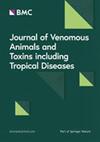Standardization of molecular techniques for the detection and characterization of intestinal protozoa and other pathogens in humans
IF 1.8
3区 医学
Q4 TOXICOLOGY
Journal of Venomous Animals and Toxins Including Tropical Diseases
Pub Date : 2022-05-06
DOI:10.1590/1678-9199-JVATITD-2021-0099
引用次数: 1
Abstract
Abstract Background: The intrinsic sensitivity limitations of basic parasitological methods, along with the particular biological characteristics of parasites, make these methods ineffective to differentiate morphologically indistinguishable species. Molecular detection and characterization techniques could be used to overcome these problems. The purpose of this work was to standardize molecular polymerase chain reaction (PCR) techniques, described in the literature, for the detection and molecular characterization of intestinal protozoa and other pathogens in humans. Methods: DNA was extracted from human or animal feces, previously washed or cultured in Boeck Drbohlav's Modified Medium. DNA extraction was performed with Machery-Nagel extraction kits. The standardization of the PCR, nested-PCR or RFLP techniques was carried out according to the literature. For each molecular technique performed, the sensitivity of the test was determined based on the minimun quantity required of DNA (sensitivity A) and the minimum quantity of life forms that the test detected (sensitivity B). Results: Sensitivity A was 10 fg for G. duodenalis, 12.5 pg for Entamoeba histolytica or Entamoeba dispar, 50 fg for Cryptosporidium spp., 225 pg for Cyclospora spp. and 800 fg or 8 fg for Blastocystis spp. after performing a 1780 bp PCR or 310 bp nested PCR, respectively. The sensitivity B was 100 cysts for G. duodenalis, 500 cysts for E. histolytica or E. dispar, 1000 oocysts for Cyclospora spp. and 3600 or four vegetatives forms for PCR or nested PCR of Blastocystis spp., respectively. Conclusions: The molecular detection of protozoa and chromist was achieved and the molecular characterization allowed the genotyping of some of the parasites such as Giardia duodenalis, Cryptosporidium spp., and Blastocystis spp. This study summarizes the molecular techniques for epidemiological studies in humans and animals, and helps in the investigation of their transmission sources in countries where intestinal parasites are a public health problem.人类肠道原生动物和其他病原体检测和鉴定分子技术的标准化
摘要背景:基础寄生虫学方法固有的敏感性限制,以及寄生虫特有的生物学特性,使得这些方法无法区分形态上难以区分的物种。分子检测和表征技术可以用来克服这些问题。本工作的目的是规范文献中描述的分子聚合酶链反应(PCR)技术,用于人类肠道原虫和其他病原体的检测和分子表征。方法:从人或动物粪便中提取DNA,经清洗或在Boeck Drbohlav改良培养基中培养。采用mach - nagel提取试剂盒进行DNA提取。根据文献对PCR、巢式PCR或RFLP技术进行标准化。对于每个分子技术执行,测试的灵敏度决定基于DNA的要求起订量(灵敏度)和生命形式的最小数量,测试检测(B)的敏感性。结果:灵敏度是10 g . duodenalis fg, 12.5 pg痢疾阿米巴痢疾dispar, 50 fg隐孢子虫spp。225 pg 800环孢子虫种虫害和成品或8 fg酵母菌属种虫害执行1780个基点PCR或310个基点后嵌套PCR,分别。十二指肠棘球绦虫的灵敏度为100个,溶组织棘球绦虫和异速棘球绦虫的灵敏度为500个,环孢子绦虫的灵敏度为1000个,囊胚绦虫的灵敏度为3600个或4个营养体。结论:本研究完成了原虫和色虫的分子检测,并对十二指肠贾第鞭毛虫、隐孢子虫和囊虫等寄生虫进行了分子分型,总结了人类和动物流行病学研究的分子技术,有助于在肠道寄生虫存在公共卫生问题的国家调查其传播源。
本文章由计算机程序翻译,如有差异,请以英文原文为准。
求助全文
约1分钟内获得全文
求助全文
来源期刊
CiteScore
4.80
自引率
8.30%
发文量
39
审稿时长
6-12 weeks
期刊介绍:
Journal of Venomous Animals and Toxins including Tropical Diseases (JVATiTD) is a non-commercial academic open access publication dedicated to research on all aspects of toxinology, venomous animals and tropical diseases. Its interdisciplinary content includes original scientific articles covering research on toxins derived from animals, plants and microorganisms. Topics of interest include, but are not limited to:systematics and morphology of venomous animals;physiology, biochemistry, pharmacology and immunology of toxins;epidemiology, clinical aspects and treatment of envenoming by different animals, plants and microorganisms;development and evaluation of antivenoms and toxin-derivative products;epidemiology, clinical aspects and treatment of tropical diseases (caused by virus, bacteria, algae, fungi and parasites) including the neglected tropical diseases (NTDs) defined by the World Health Organization.

 求助内容:
求助内容: 应助结果提醒方式:
应助结果提醒方式:


